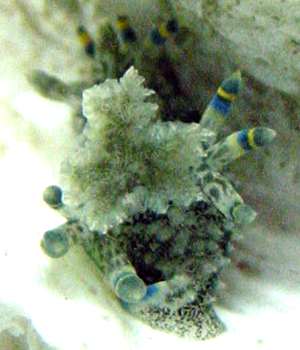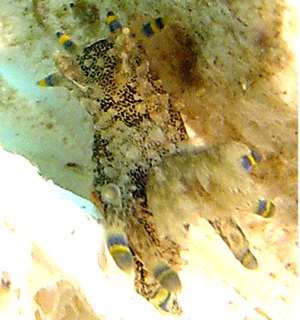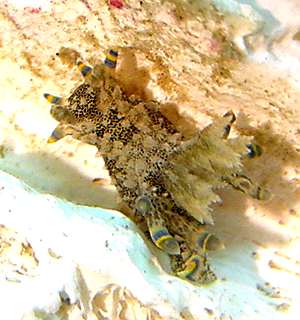Re: Polycera hummi from Florida
January 12, 2004
From: Karen Mudgett

Dear Bill,
Thank you so much for your help in identifying our animal. I'm happy to know that we have made some form of contribution for this species. My husband, Sean, and I took some more pictures of him tonight, I'm sending three.
As far as I know, we've only seen two other species in our trips to the shore. One, we identified as the Ragged Sea Hare, and through this Forum, learned as much as we could about them. Actually, it wasn't long after reading the page on mass mortality that we encountered this. There were hundreds in water that was only a couple inches deep, forming circles, lines, and clumps, breeding. We were going to take pictures, but by the time we returned with the camera, it was over, they were gone. Over the next few days we found them washing in to shore. We brought four of the ones that were still alive home, but the next day they laid eggs and died. The other sea slug we found was an accident, we gathered some clumps of dead oysters to put in our tank, to give our blennies and other small fish something more to hide around, and one day after putting the oysters in the tank we spotted a sea slug, we never figured out what species, and we never saw him after that, all I can remember was that he had a pink head and a green body. I hope we find another like him so we can get pictures.
I didn't think about it at the time, but we did pull some bryozoans up with the Polycera hummi, they are arborescent, but I wouldn't know one species from another. Also, as a side note, I had no idea that this was such a rare thing, so I would like to clarify where he was found, the dock we were at is on Anna Maria Island, Manatee County, Florida. This way, if you're making some sort of record, it'll be more accurate.
Thank you again,
Karen Mudgett
anoksunamun@wildmail.net


Dear Karen,
Glad to help and glad to get the observation. It's a good example of how the Forum brings together professional scientists and interested amateurs to our mutual benefit. It;s good to get photos from this angle because they clearly show that there are 2 anterior papillae in front of each rhinophore and 3 posterior ones on each side of the gills.
Thanks also for the photo in your separate message of its egg ribbon - another new bit of information
Best wishes
Bill Rudman
Related messages
-
Polycera hummi from Gulf of Mexico
From: Kasey L. Grace, June 1, 2010 -
Polycera hummi from Mississippi, USA
From: Gretchen Grammer, November 21, 2007 -
Re: Polycera hummi from North Carolina
From: Anthony Fernando, December 6, 2006 -
Polycera hummi from North Carolina
From: Tony Fernando, November 22, 2006 -
Re: Polycera hummi from Florida
From: Karen Mudgett, July 11, 2004 -
Egg-ribbon of Re: Polycera hummi
From: Karen Mudgett, January 12, 2004 -
Polycera hummi from Florida
From: Karen Mudgett, January 9, 2004
